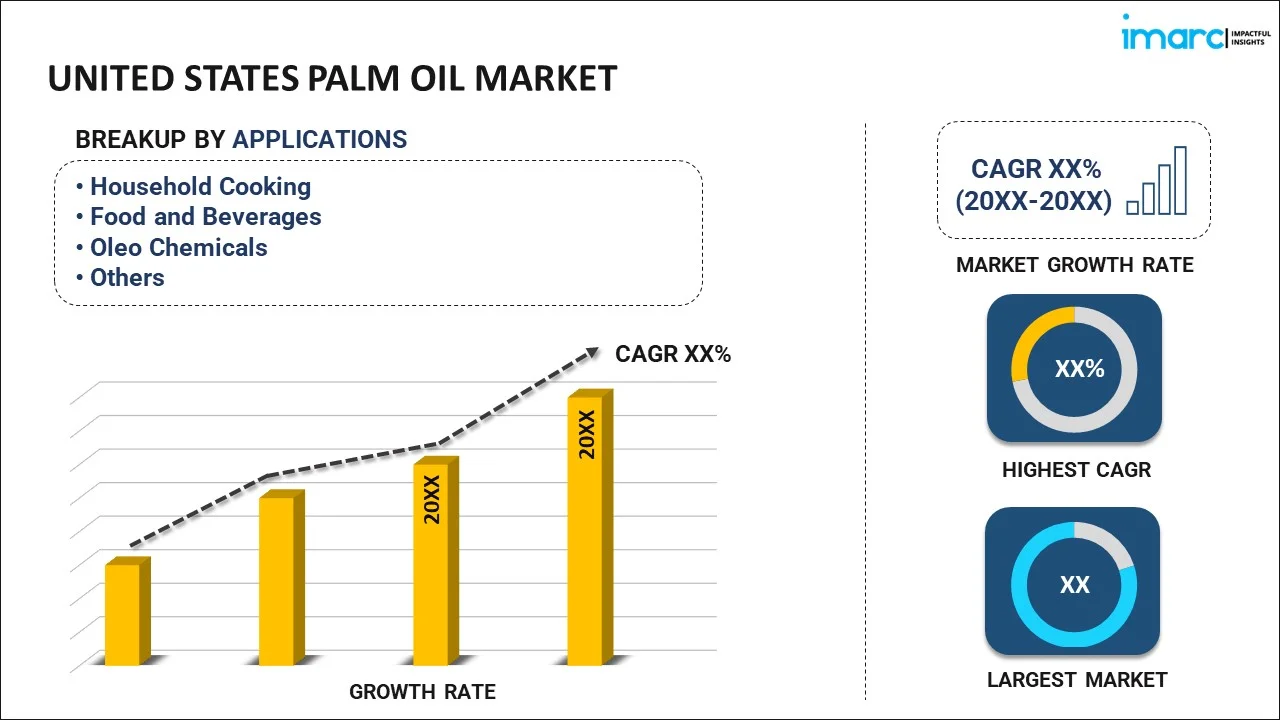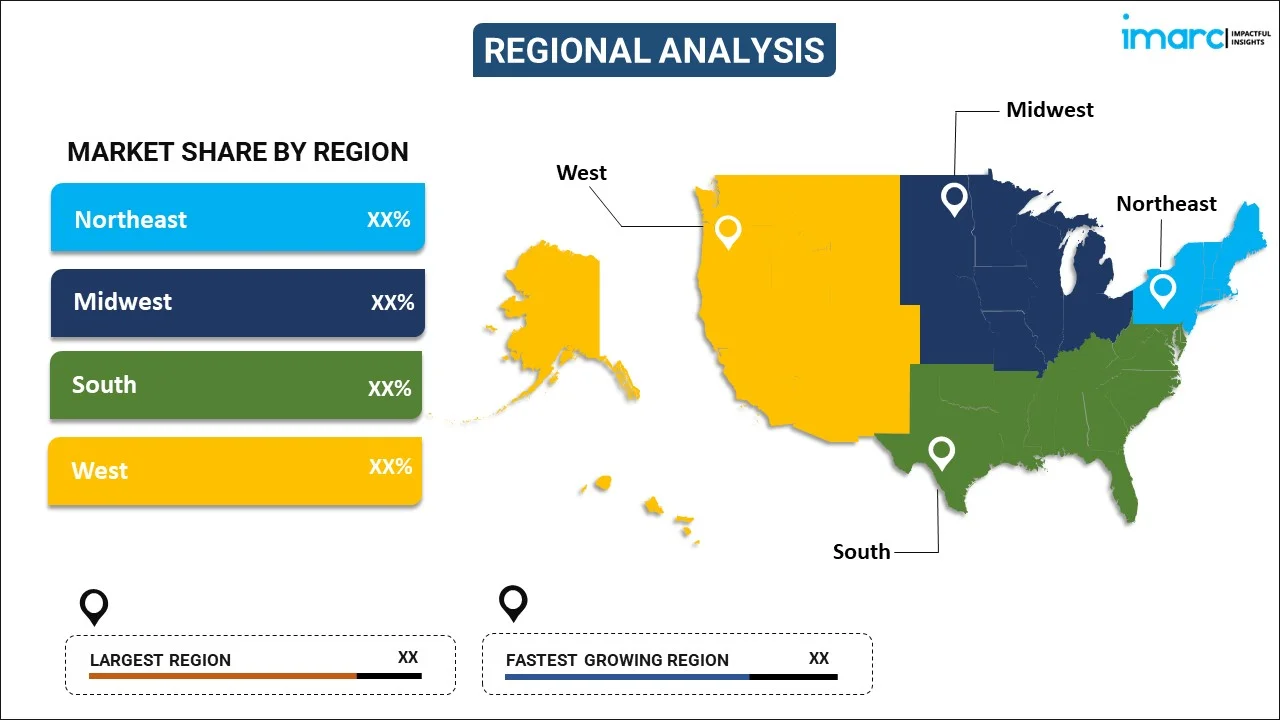
United States Palm Oil Market Report by Application (Household Cooking, Food and Beverages, Oleo Chemicals, Personal Care, Animal Feed, Bio-Fuel), and Region 2025-2033
United States Palm Oil Market Size, Share & Analysis:
United States palm oil market size reached USD 13.8 Billion in 2024. Looking forward, IMARC Group expects the market to reach USD 21.4 Billion by 2033, exhibiting a growth rate (CAGR) of 5% during 2025-2033. The escalating demand for processed cooking oils, along with the expanding middle class population, is primarily driving the market growth across the country.
|
Report Attribute
|
Key Statistics
|
|---|---|
|
Base Year
|
2024 |
|
Forecast Years
|
2025-2033
|
|
Historical Years
|
2019-2024
|
| Market Size in 2024 | USD 13.8 Billion |
| Market Forecast in 2033 | USD 21.4 Billion |
| Market Growth Rate (2025-2033) | 5% |
United States Palm Oil Market Insights:
- Major Market Drivers: The United States palm oil industry is propelled by increasing demand in food processing, increasing utilization as a biofuel, and cost advantage over other vegetable oils, combined with shifting regulations towards renewable and sustainable ingredient sourcing.
- Key Market Trends: Major trends encompass growing uptake of sustainable sourcing methods, implementation of traceability technologies, and growth in palm oil use in plant-based food and bakery items to substitute trans fat and hydrogenated oils as consumers become more health-conscious.
- Competitive Landscape: The competitive environment is defined by domestic importers, distributors, and refiners prioritizing quality, sustainability certification, and logistics and supply chain technology innovation to achieve regulatory compliance and increasing ethical consumption expectations.
- Challenges and Opportunities: Although sustainability issues and import laws are threats, opportunities come in the form of increasing biofuel uses, clean-label food creativity, and investment in traced, certified palm oil to satisfy changing consumers and regulatory needs within the United States market.
United States Palm Oil Market Trends:
Growing Usage of Palm Oil in Biodiesel Production
The growing demand of palm oil for biodiesel production is a characteristic trend influencing the United States palm oil market growth. The high oxidative stability and low cost of production of palm oil make it a viable feedstock for biofuel production compared to soybean or canola oil. With increasing regulatory focus on reducing carbon emissions, especially under renewable fuel obligations, palm oil is being used in blends of biodiesel to help achieve clean energy targets. The fact that it can help create biodiesel with good cold flow characteristics also adds to its functionality in diversified climatic conditions found in the U.S. States that encourage the use of renewable fuel sources are also offering incentives, thereby indirectly supporting palm-derived biodiesel demand. Reflecting this trend, in August 2024 the U.S. Environmental Protection Agency (EPA) launched audits into at least two domestic biodiesel producers over concerns some were mislabeling virgin palm oil as used cooking oil to qualify for RFS and tax subsidies—highlighting the regulatory attention palm-based feedstocks are drawing in the U.S. biofuels market. Moreover, this increasing usage in the energy market not only expands its application beyond conventional food markets but also aids supply chain growth. All these developments are in favor of a positive United States palm oil market forecast as biodiesel becomes a mainstay of renewable fuel policies.
Increased Use of Palm Oil in Processed Foods and Bakery
Palm oil is increasingly popular with food manufacturers because of its functional properties, and it is a major contributor to United States palm oil market size. Having a semi-solid form at ambient temperature and high shelf-stability, palm oil finds extensive application in baked food, snacks, margarine, and dairy alternatives. Its trans-fat-free profile meets health norms and consumer demand for clean labels on food products. With U.S. consumers trending toward packaged and ready-to-eat foods, there is a corresponding increased demand for stable, economical, and dependable ingredients such as palm oil. This trend is complemented by food processors reformulating to phase out partially hydrogenated oils, thus choosing palm oil as a suitable alternative. Bakery and processed foods are leading sectors driving the demand, particularly in commercial-sized kitchens and fast-moving consumer goods. These dynamics indicate a consistent rise in United States palm oil market share across food and beverage industry applications.
Technological Developments in Supply Chain Transparency
Digitalization is taking center stage in enhancing transparency and sustainability in the palm oil sector, thus shaping the market analysis. Blockchain, satellite tracking, and sophisticated data analytics are being harnessed to upgrade traceability from farm to end-user. These innovations enable stakeholders to make sure palm oil imports meet ethical sourcing standards, mandates of biodiversity protection, and land-use controls. Consumers, government agencies, and retailers increasingly focus on confirmed sustainable methods, so traceable supply chains are not only helpful but also essential. The tools also help identify deforestation-free supply chains and encourage accountability among suppliers. As per United States palm oil market analysis, whose commodity demand is strong in ethically produced commodities, technological changes are necessary to ensure market credibility and harmonization. This transformation in supply chain management enhances confidence and drives long-term market growth, particularly among institutional and environmentally friendly consumer bases.
United States Palm Oil Market Segmentation:
IMARC Group provides an analysis of the key trends in each segment of the market, along with forecasts at the country level for 2025-2033. Our report has categorized the market based on application.
Application Insights:

To get more information on this market, Request Sample
- Household Cooking
- Food and Beverages
- Oleo Chemicals
- Personal Care
- Animal Feed
- Bio-Fuel
The report has provided a detailed breakup and analysis of the market based on the application. This includes household cooking, food and beverages, oleo chemicals, personal care, animal feed, and bio-fuel.
Regional Insights:

- Northeast
- Midwest
- South
- West
The report has also provided a comprehensive analysis of all the major regional markets, which include Northeast, Midwest, South, and West.
Competitive Landscape:
The market research report has also provided a comprehensive analysis of the competitive landscape in the market. Competitive analysis such as market structure, key player positioning, top winning strategies, competitive dashboard, and company evaluation quadrant has been covered in the report. Also, detailed profiles of all major companies have been provided.
Latest News and Developments:
- In September 2024, Satelligence and ImpactBuying teamed up to ensure EUDR compliance via assured deforestation-free supply chains. While EU-centric, the partnership mirrors increasing global pressure on traceable sourcing, by proxy pressing U.S. stakeholders to conform with such similar ESG frameworks, directly impacting sustainability practices in the United States palm oil market.
- In March 2024, U.S. firm Colgate-Palmolive collaborated with NoPalm Ingredients to create soap bars through fermentation-based oils. This is a sign of the direction toward sustainable alternative oils, a move that could potentially minimize future dependency on palm oil in the United States palm oil market through cleaner, land-efficient ingredient uptake for personal care products.
United States Palm Oil Market Report Coverage:
| Report Features | Details |
|---|---|
| Base Year of the Analysis | 2024 |
| Historical Period | 2019-2024 |
| Forecast Period | 2025-2033 |
| Units | Billion USD |
| Scope of the Report | Exploration of Historical and Forecast Trends, Industry Catalysts and Challenges, Segment-Wise Historical and Predictive Market Assessment:
|
| Applications Covered | Household Cooking, Food and Beverages, Oleo Chemicals, Personal Care, Animal Feed, Bio-Fuel |
| Regions Covered | Northeast, Midwest, South, West |
| Customization Scope | 10% Free Customization |
| Post-Sale Analyst Support | 10-12 Weeks |
| Delivery Format | PDF and Excel through Email (We can also provide the editable version of the report in PPT/Word format on special request) |
Key Benefits for Stakeholders:
- IMARC’s industry report offers a comprehensive quantitative analysis of various market segments, historical and current market trends, market forecasts, and dynamics of the United States palm oil market from 2019-2033.
- The research report provides the latest information on the market drivers, challenges, and opportunities in the United States palm oil market.
- Porter's five forces analysis assist stakeholders in assessing the impact of new entrants, competitive rivalry, supplier power, buyer power, and the threat of substitution. It helps stakeholders to analyze the level of competition within the United States palm oil industry and its attractiveness.
- Competitive landscape allows stakeholders to understand their competitive environment and provides an insight into the current positions of key players in the market.
Key Questions Answered in This Report
The palm oil market in the United States was valued at USD 13.8 Billion in 2024.
The United States palm oil market is projected to exhibit a (CAGR) of 5% during 2025-2033, reaching a value of USD 21.4 Billion by 2033.
Market drivers in the United States palm oil market are mainly driven by its growing usage in processed foods, bakery, and confectionery owing to its long shelf life and stability. Increasing demand for renewable biofuels, heightened preference for trans-fat-free options, and affordability of palm oil in comparison to other vegetable oils are further driving its adoption in food, industrial, and energy applications.
Need more help?
- Speak to our experienced analysts for insights on the current market scenarios.
- Include additional segments and countries to customize the report as per your requirement.
- Gain an unparalleled competitive advantage in your domain by understanding how to utilize the report and positively impacting your operations and revenue.
- For further assistance, please connect with our analysts.
 Request Customization
Request Customization
 Speak to an Analyst
Speak to an Analyst
 Request Brochure
Request Brochure
 Inquire Before Buying
Inquire Before Buying




.webp)




.webp)












